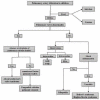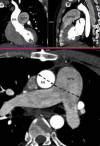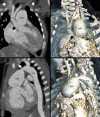Pulmonary Arterial Dilatation: Imaging Evaluation Using Multidetector Computed Tomography
- PMID: 34556926
- PMCID: PMC8448224
- DOI: 10.1055/s-0041-1734225
Pulmonary Arterial Dilatation: Imaging Evaluation Using Multidetector Computed Tomography
Abstract
Pulmonary artery dilatation comprises a heterogeneous group of disorders. Early diagnosis is important as the presentation may be incidental, chronic, or acute and life threatening depending upon the etiology. Cross-sectional imaging plays an important role, with CT pulmonary angiography being regarded as the first line investigation in the evaluation of pulmonary artery pathologies. Moreover, effects of pulmonary artery lesions on proximal and distal circulation can also be ascertained with the detection of associated conditions. Special attention should also be given to the left main coronary artery and the trachea-bronchial tree as they may be extrinsically compressed by the dilated pulmonary artery. In context of an appropriate clinical background, CT pulmonary angiography also helps in treatment planning, prognostication, and follow-up of these patients. This review mainly deals with imaging evaluation of the pulmonary arterial dilatations on CT with emphasis on the gamut of etiologies in the adult as well as pediatric populations.
Keywords: cardiac shunt; pulmonary arterial hypertension; pulmonary artery dilatation; pulmonary thromboembolism; vasculitis.
Indian Radiological Association. This is an open access article published by Thieme under the terms of the Creative Commons Attribution-NonDerivative-NonCommercial-License, permitting copying and reproduction so long as the original work is given appropriate credit. Contents may not be used for commercial purposes, or adapted, remixed, transformed or built upon. (https://creativecommons.org/licenses/by-nc-nd/4.0/).
Conflict of interest statement
Conflict of Interest None declared. Authors’ Contributions All authors contributed to the conception or design, literature search, drafting, critical revision, and final approval of the manuscript.
Figures












References
-
- Carter B W, Lichtenberger J P, III, Wu C C. Congenital abnormalities of the pulmonary arteries in adults. AJR Am J Roentgenol. 2014;202(04):W308–13. - PubMed
-
- McLoud T C, Boiselle P M. Thoracic radiology: imaging methods, radiographic signs, and diagnosis of chest disease. In: McLoud TC, Boiselle PM, eds. Thoracic Radiology: The Requisites. 2nd ed. Philadelphia, PA: Elsevier. 2010:8.
-
- Frazier A A, Galvin J R, Franks T J, Rosado-De-Christenson M L. From the archives of the AFIP: pulmonary vasculature: hypertension and infarction. Radiographics. 2000;20(02):491–524. - PubMed
-
- Wittram C. How I do it: CT pulmonary angiography. AJR Am J Roentgenol. 2007;188(05):1255–1261. - PubMed
Publication types
LinkOut - more resources
Full Text Sources

